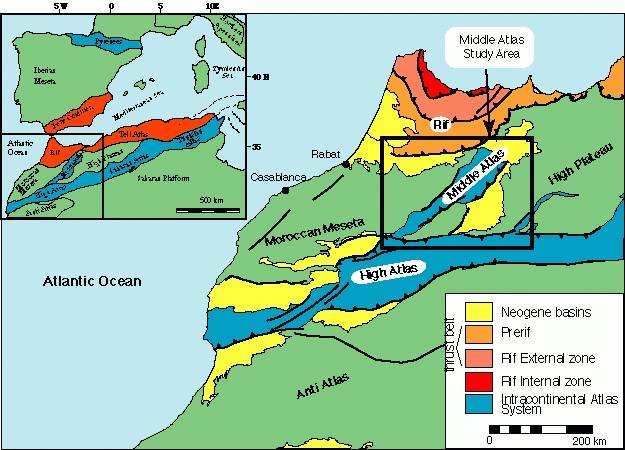![]()
![]()
Participants:
Sponsored by the National Science Foundation (NSF)
This works is a collaborative effort with the following Moroccan Institutions:
![]()
 (Click
here for tectonic map.)
(Click
here for tectonic map.)
Project Summary (modified from NSF proposal)
The collision between Africa nad Europe in the western Mediterranean region resulted in a complex plate boundary with a broad zone of deformation. The intraplate Atlas mountain system of Morocco is a significant part of this active zone of deformation that has been influenced by Early Mesozoic rift structures inverted during the Cenozoic. Quaternary and present-day tectonism is evidenced by deformed Quaternary sediments, Quaternary alkali volcanism, and crustal seismicity.
This research comprises a multidisciplinary effort that will help to understand the nature of the intracontinental deformation in the Atlas system and the relationship between the Atlas Mountains and the Rif-Betic interplate mountain belt. This study focuses on the noreast trending Middle Atlas system. Depending upon whether there is a master decollement, a wrench fault system, or some other (yet to be determined) model, there are different predictions concerning the following problems:
These problems, however, are not well understood. The first two problems are related to the kinematic scheme of the Middle Atlas. Results from preliminary work suggest significant variations, such as normal faulting and the lack of strike-slip deformation within the mountain belt as suggested by the transpressive wrench model. This is being further investigated using kinematic results from the analysis of microtectonic data and earthquake focal mechanisms in the region. The third issue is related to the state of stress in the upper crust. This will be examined by relating the results of stress-inversion analyses and geometrical aspects of the neotectonic faults and other related structures in the region with the reported physical properties of the extrusive rocks. New observations have been collected in the course of field work. The fourth problem will be approached with the use of seismic reflection data and exploratory well logs in an effort to analyze the subsurface structural styles in the Middle Atlas system and provide estimates of neotectonic shortening across the mobile zone. The intersection between the Middle Atlas and Rif thrust system will also be examined near the Guercif Basin.
Addressing these problems will allow the evaluation of existing tectonic models and formulation of new hypotheses for the Middle Atlas. The kinematics of the Atlas deformation will be related to the plate boundary processes to gain a better understanding of foreland deformation in a complicated collisional zone.
![]()
![]()
Last modified April 16, 1997.